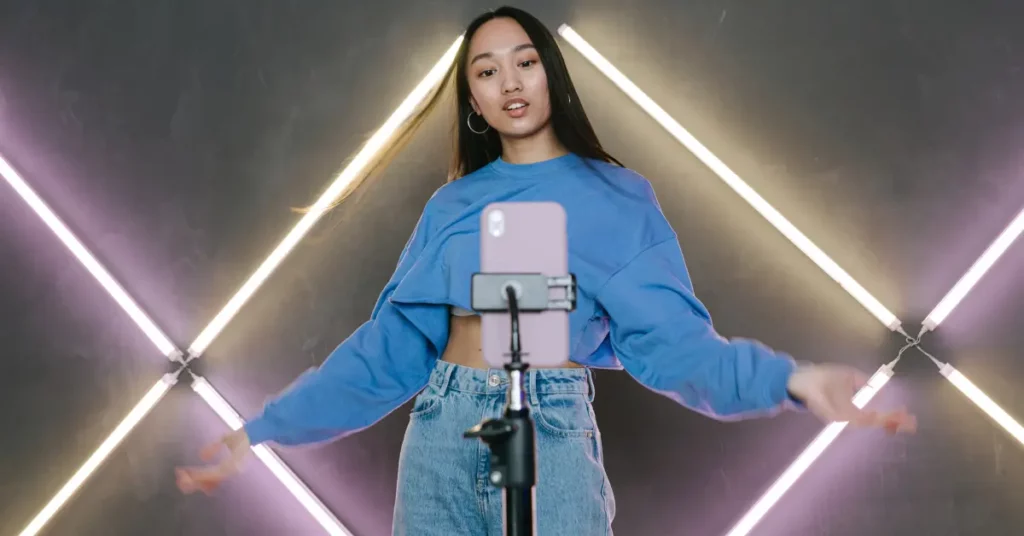Social commerce represents a significant shift in the retail landscape, combining the power of social media with the convenience of online shopping. It’s a digital phenomenon where social platforms become marketplaces, allowing users to make purchases directly through their feeds. This integration transforms traditional e-commerce by leveraging social interactions and influencer endorsements to drive sales. Social commerce breaks down the barriers between product discovery and purchase, offering a user-friendly shopping experience. It’s particularly effective in retail, where recommendations play a critical role in consumer decisions. The essence of social commerce lies in its ability to blend the social aspect of shopping with the efficiency of online transactions.

The Influential Role of Influencers in Social Media Commerce
In the realm of social commerce, influencers have a profound impact on shaping consumer preferences. Their ability to sway public opinion and dictate trends is unparalleled, especially in a digital era where social media is a daily staple for many. Influencers possess a unique blend of relatability and authority, making their recommendations particularly persuasive. They often serve as trendsetters, introducing new products and brands to their followers.
Engagement with influencers is a potent tool for driving sales within retail social commerce. When influencers showcase or endorse a product, it often leads to immediate and measurable spikes in sales. This effect is heightened due to the authentic connection influencers have with their audience. They are seen as trusted peers rather than traditional advertisers, making their endorsements more effective. Strategic collaborations with influencers can lead to highly successful marketing campaigns.
A beauty brand may partner with influencers to create tutorial videos using their products, resulting in increased brand awareness and sales. On the other hand, a fashion brand launching an exclusive clothing line with a well-known influencer drives audience sales. These campaigns not only leverage the influencer’s reach but also benefit from the authenticity and creative content that influencers are known for, making them more effective than traditional advertising methods.
The influencer-consumer connection is a pivotal aspect of social e-commerce. This connection is built on trust, relatability, and engagement. Influencers who have a genuine relationship with their audience can influence their followers’ shopping habits more effectively. This connection is often cultivated over time, through consistent and engaging content. Understanding this dynamic is crucial for brands looking to leverage influencers in social commerce. It’s not just about the number of followers an influencer has, but the quality of engagement and the trust they have built with their audience.
Influencer Impact on Social Commerce in Retail
In the context of social commerce in retail, influencers play a crucial role in enhancing brand visibility. For instance, when a renowned influencer features a product in their content, it can immediately put a brand on the radar of thousands, if not millions, of potential customers. This exposure is particularly valuable for emerging brands that might struggle to gain visibility in a crowded marketplace. Through influencer partnerships, these brands can reach a wider audience, create buzz, and establish credibility in a relatively short period.
Sales growth through influencer partnerships is a tangible measure of success in retail social commerce. Brands often witness a direct correlation between influencer campaigns and an uptick in sales. This effect can be attributed to the influencer’s ability to create a sense of urgency and exclusivity around a product, prompting their followers to make prompt purchasing decisions. Additionally, influencers can provide valuable feedback and insights from their audience, allowing brands to refine their products and marketing strategies further. To maximize the benefits of collaborating with influencers in social commerce, certain best practices should be followed:
Choose the Right Influencer: It’s vital to partner with influencers who not only have a substantial and engaged following but whose values and audience demographics align closely with your brand. This alignment ensures that the influencer’s recommendations appear credible and resonate well with their audience, thereby increasing the likelihood of conversion. For instance, a beauty brand would benefit more from partnering with an influencer who regularly posts about skincare and cosmetics rather than one who focuses on unrelated topics like technology or travel.
Foster Authentic Relationships: Authenticity should be the cornerstone of any influencer partnership. Collaborations should feel genuine and natural, not just to the influencer but also to their audience. When influencers truly believe in the products they promote, their endorsements come across as more sincere, which significantly boosts their effectiveness. Building a real relationship with influencers, involving regular communication and mutual respect, can enhance the authenticity of the partnership and lead to more successful campaigns.
Set Clear Objectives and Expectations: Clearly define what each party expects from the collaboration from the start. Establish specific goals, whether they’re related to sales targets, engagement rates, or specific content deliverables, and set up transparent communication channels. This clarity helps prevent misunderstandings and ensures that both the brand and the influencer work cohesively towards common objectives, maximizing the impact of their joint efforts.
Create Engaging and Unique Content: Encourage influencers to develop content that is authentic to their unique style while still aligning with your brand’s message. This approach ensures that the content not only appeals to the influencer’s audience but also carries a consistent brand message. Creative freedom helps influencers produce genuine content that can captivate their followers more effectively than overtly promotional or unnatural posts.
Utilize Multiple Platforms: To maximize reach and impact, don’t limit campaigns to a single platform. Different social media channels cater to varied audience demographics and behaviors, so using multiple platforms can broaden your reach and enhance engagement across different segments. For example, combining Instagram’s visual appeal with Twitter’s conversational nature and YouTube’s depth of content can cover a wider spectrum of audience preferences and interactions.
Evaluating the return on investment (ROI) in influencer marketing is a crucial step in understanding its effectiveness. Metrics such as engagement rates, conversion rates, and overall reach can provide insights into how well the influencer’s content is resonating with the audience and influencing purchasing decisions. Analyzing these metrics helps brands fine-tune their strategies and make informed decisions about future influencer partnerships.
Exploring Social Commerce Platforms for Influencer Collaborations
Social commerce platforms like Instagram, Facebook, and TikTok offer unique opportunities for influencer collaborations. Each of these platforms offers distinct tools and audiences, making them valuable for different aspects of influencer marketing in social commerce. Here’s how:
Instagram: This platform is ideal for showcasing high-quality visuals and stories that highlight products in an aesthetically pleasing manner. Influencers can leverage Instagram’s Shopping features, which allow users to make purchases directly through posts or stories. This seamless integration of browsing and buying enhances the shopping experience, making it efficient and engaging. Instagram’s visually rich format is perfect for fashion, beauty, and lifestyle sectors, where product appearance can significantly influence buying decisions.
Facebook: Facebook excels in building and nurturing communities around brands. Influencers can use Facebook Groups to create a dedicated space for fans and followers, fostering a sense of belonging and loyalty. Additionally, Facebook’s live video feature is an excellent tool for real-time engagement, allowing influencers to host Q&A sessions, product demonstrations, or behind-the-scenes tours. Facebook’s detailed targeting options for advertisements further enable brands to reach specific demographics, enhancing the effectiveness of marketing campaigns tailored to diverse audience segments.

TikTok: Known for its dynamic and creative environment, TikTok is the go-to platform for short-form video content. Influencers can tap into the latest trends and challenges, creating engaging and relatable content that resonates with a younger audience. By participating in popular challenges or initiating original branded challenges, influencers can dramatically increase brand visibility and engagement. TikTok’s algorithm favors content that gains traction quickly, so timely and trend-aligned videos are more likely to achieve viral status, amplifying reach and impact.
Trends in influencer marketing vary across platforms, reflecting the unique user demographics and content styles of each. On Instagram, lifestyle and fashion content dominate, while TikTok favors more dynamic, trend-driven content. Facebook trends lean towards longer-form content and community building. Keeping up with these trends is essential for brands to remain relevant and effective in their influencer marketing efforts.
Examining platform-specific influencer case studies provides valuable insights into successful strategies and outcomes. For example, a beauty brand may use Instagram influencers for visually-rich product demonstrations, while on TikTok, the same brand could engage in a viral makeup challenge. These highlight the importance of adapting influencer strategies to suit the strengths and user base of each platform.
The Rise of Influencers in Social E-Commerce
The rise of TikTok social commerce has showcased the immense power of influencers on this platform. As mentioned previously, TikTok’s unique format of short, engaging videos creates an ideal environment for influencers to rapidly gain a massive following and exert significant influence. Brands partnering with TikTok influencers benefit from their ability to create viral content that resonates with a young, trend-savvy audience. These influencers have mastered the art of blending entertainment with subtle product promotions, making their endorsements effective for driving sales.
Creating engaging influencer content is pivotal in the success of social commerce TikTok strategies. Influencers excel in creating stories around products, showing their use in everyday life, or entertaining ways. This approach makes the content more appealing and relatable to its audience, increasing the likelihood of engagement and sharing.
Analyzing TikTok’s format reveals why it’s so effective for influencer marketing. The platform’s emphasis on short, captivating videos caters perfectly to the decreasing attention spans of online audiences. TikTok’s algorithm also favors content that gains early engagement, giving influencers a unique opportunity to reach audiences beyond their followers. This environment encourages creativity and spontaneity, allowing influencers to experiment with different content styles and trends, which can be highly effective for brands looking to make an impact in the social e-commerce space.
Trends and innovations in TikTok social commerce are continually evolving, keeping the platform fresh and engaging. Recent trends include the use of augmented reality (AR) filters for trying on products, live streaming for real-time engagement, and co-creation campaigns where users can contribute their content. These innovations not only enhance the shopping experience but also create new opportunities for influencers and brands to engage with their audience in creative ways.
Integrating Influencers into Social Commerce Websites
Integrating influencers into social commerce websites is a strategic approach to enhance the online shopping experience. Influencers can provide a human touch to digital storefronts. Their involvement can range from featuring on product pages with their reviews and photos to hosting live sessions on the site, giving a real-time demonstration of products.
Influencers, with their substantial reach and persuasive power, play a crucial role in this process. They can engage the audience in various ways that promote a vibrant and interactive community. Here’s a deeper look at each method:
Q&A Sessions: Influencers can host regular Q&A sessions, providing a platform for followers to voice their questions and concerns directly. This interactive setup makes the audience feel valued and heard, strengthening their connection to the brand. It also allows influencers to clarify misconceptions, share deeper insights about the products, and demonstrate their commitment to transparency and customer support.
Offer Advice: By offering advice and sharing expertise related to the brand’s products, influencers can significantly enhance customer knowledge and trust. This might include tips on how to use products effectively, advice on choosing the right product variants, or ideas for integrating products into daily routines. Such valuable content not only educates the audience but also positions the influencer as a credible authority, boosting confidence in both the influencer and the brand.
Share Personal Experiences: When influencers share their personal stories and experiences with the brand’s products, it adds a layer of authenticity and relatability. These personal testimonials can resonate deeply with the audience, influencing their purchasing decisions. Additionally, sharing such experiences encourages followers to discuss their interactions with the brand, fostering a community feeling and promoting user-generated content that can further enhance the brand’s credibility and appeal.
These strategies collectively contribute to building a strong, engaged community around a brand. Influencers, by implementing these tactics, not only enhance their reliability and connection with their audience but also significantly boost the brand’s image and customer loyalty.
Leveraging Social Commerce Tools for Influencer Marketing
The field of influencer marketing in social commerce platforms is continuously evolving with technological innovations. Advanced analytics tools are now capable of providing deeper insights, like sentiment analysis and predictive modeling. Artificial intelligence (AI) is being leveraged to identify potential influencer partnerships and to optimize content strategy. Moreover, AR and VR technologies are opening new avenues for influencers to create immersive and interactive content, enhancing the overall impact of social commerce campaigns.

The trends in influencer marketing tools are set to become even more sophisticated. We can expect the integration of machine learning algorithms to provide more nuanced insights into consumer behavior and influencer effectiveness. Tools will likely become more adept at measuring the indirect impact of influencers, such as brand loyalty and long-term customer value. Additionally, the rise of decentralized social platforms and blockchain technology could introduce new ways of tracking and authenticating influencer engagements and transactions.
The future of influencers in social commerce appears increasingly integrated and technologically sophisticated. We can anticipate a greater emphasis on long-term partnerships where influencers become integral brand ambassadors. The role of data analytics in shaping influencer marketing strategies will become more pronounced, offering sharper insights into consumer behavior and campaign performance. Additionally, as social commerce continues to evolve, there will be a growing focus on sustainability and ethical practices in influencer collaborations. The future of influencer marketing in social commerce is not just about reaching more people; it’s about building more meaningful, authentic, and value-driven connections with consumers.
